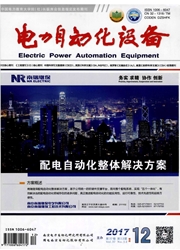

 中文摘要:
中文摘要:
针对具有风电和火电机组的电力系统,在储能系统配置给定的前提下,提出通过储能尽量消除风电不确定性并部分以备用形态出现的研究思路,建立了火电机组组合2层优化决策模型。上层问题以火电机组组合成本最小为目标,下层问题以储能系统对电网中电能时空平移和提供备用所得收益最大为目标,以储能系统消除不确定性程度为满足对象,其中计及了自动发电控制(AGC)机组和非AGC机组的特性,以及系统频率调节效应的作用。基于分解协调的原理,通过上、下层问题的交替迭代对该模型予以求解,决策储能系统充/放电功率、调控范围及机组启停方案。该方法可在减少火电机组备用容量的同时,提升系统应对不确定性的能力,通过10机组系统验证了模型和方法的有效性。
 英文摘要:
英文摘要:
A two-level optimization model of thermal unit commitment is built for the hybrid windthermal power system with given capacity of ESS(Energy Storage System),which uses ESS to eliminate the uncertainty of wind power as much as possible and to provide partial power generation reserve. Its upper layer is to minimize the cost of thermal unit commitment and its lower layer is to maximize the benefits from the spatio-temporal translation of electric energy and the reserve provided by ESS as well as the uncertainty elimination degree. The effect of system frequency regulation and the performances of AGC( Automatic Generation Control) and non-AGC units are considered in the model. Based on the principle of decomposition and coordination,the model is solved by the alternating iterations between upper and lower layers to obtain the charge/discharge schedule and regulation range of ESS as well as the thermal unit commitment scheme,showing that the power generation reserve of thermal units is reduced and the ability to cope with system uncertainty improved. The validity of the proposed model and method is verified with a 10-unit system.
 同期刊论文项目
同期刊论文项目
 同项目期刊论文
同项目期刊论文
 Calculation of Power Transfer Limit Considering Electro-Thermal Coupling of Overhead Transmission Li
Calculation of Power Transfer Limit Considering Electro-Thermal Coupling of Overhead Transmission Li 期刊信息
期刊信息
